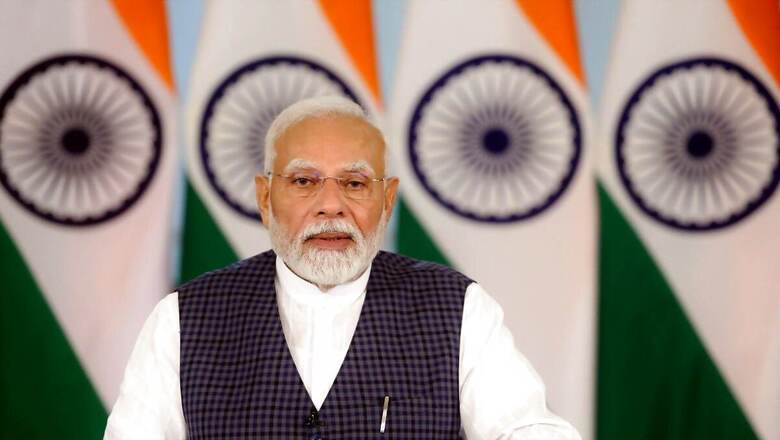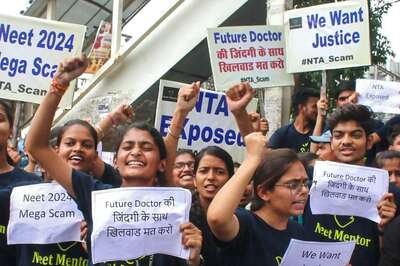
views
In October 2001, Narendra Modi was sworn-in as the Gujarat CM for the first time. In the past 23 years, PM Narendra Modi’s leadership has been a beacon of transformation, first revitalising Gujarat and then setting India on an unprecedented path of progress.
Today, India’s global standing and its strides in digitalisation, infrastructure and social welfare all bear the mark of his unwavering commitment to development.
GUJARAT BEFORE 2001: A STATE IN CRISIS
In the mid-1980s, Gujarat faced an unprecedented crisis, with three consecutive droughts from 1985 to 1987. The situation was dire—out of 18,000 villages, 11,000 had no access to drinking water. Thousands of livestock perished due to the lack of grasslands, and with crops failing, people began migrating out of the state in search of better opportunities. Gujarat’s economy had nearly collapsed, as agricultural distress paralysed rural livelihoods and industries faced supply chain disruptions.
NARENDRA MODI TAKES OVER AS CHIEF MINISTER OF GUJARAT
In 2001, against this backdrop of desperation and despair, Narendra Modi took over as the Chief Minister of Gujarat. His first and most pressing task was to tackle the state’s severe water shortage and revive its crippled economy. Modi launched the Sujalam Sufalam Yojana, a groundbreaking initiative focused on water conservation and management. Under this scheme, an intricate network of canals, check dams and reservoirs was constructed to meet the state’s water needs year-round. The project not only replenished groundwater levels, but also made Gujarat water surplus, turning the state’s fortunes around. Moreover, Modi’s emphasis on decentralised governance empowered local communities to take ownership of water resources, laying the groundwork for long-term sustainability.
Another significant intervention was the Jyotigram Yojana, which provided 24-hour electricity to rural Gujarat. This transformed the agricultural sector, allowing farmers to access water pumps and modern machinery, while also fostering small-scale industries. Modi’s leadership during this time not only resolved the state’s immediate water and energy crisis, but also laid the foundation for Gujarat’s economic resurgence.
Modi’s tenure as the Chief Minister of Gujarat left an indelible mark through ambitious projects that combined development with visionary governance. The Vibrant Gujarat Summit, launched in 2003, became a platform to attract global investments. Modi positioned Gujarat as an investor-friendly state, and by the time he left office, the summit had garnered billions in commitments, transforming the state into an industrial powerhouse.
Projects like the Sabarmati Riverfront turned neglected areas into flourishing public spaces, boosting both tourism and urban development. The riverfront not only enhanced the city’s aesthetic appeal, but also rejuvenated the local economy by attracting businesses, events and festivals.
INDIA BEFORE 2014: A NATION IN STAGNATION
Before Narendra Modi assumed office as the Prime Minister in 2014, India faced a multitude of challenges. During the UPA era, India was struggling with policy paralysis, high inflation and a sluggish economy. Corruption scandals such as the 2G spectrum scam and coal allocation scam had severely dented public trust in the government, and economic growth had slowed down significantly. Infrastructure projects were delayed, investor confidence was low, and the business environment was marred by bureaucratic hurdles and red tape. The country was burdened with widespread poverty, with frequent power shortages acting as a major bottleneck to economic growth. Quality healthcare was inaccessible. Medical expenses were driving millions of families deeper into poverty.
2014: MODI TAKES THE OATH AS INDIA’S PRIME MINISTER
When Narendra Modi became the Prime Minister in 2014, he undertook the monumental task of rebuilding India from the ground up. One of his most far-reaching initiatives was the Digital India Mission, which aimed to transform India into a digitally empowered society. By focusing on expanding internet access, digital literacy, and online government services, Modi brought millions of citizens into the digital fold, making e-governance more accessible and transparent.
The Swachh Bharat Abhiyan revolutionised public health and sanitation across the country. This massive cleanliness drive made over 100 million toilets accessible, declaring villages open defecation free, improving overall health, and drastically reducing diseases related to poor sanitation.
Through the PM-Kisan Samman Nidhi, Modi directly addressed the plight of farmers by providing income support to 11 crore farmers. This was a game-changer for India’s agrarian community, alleviating debt pressures and enabling farmers to invest in better resources for their crops.
The PM Awas Yojana has built over 4 crore houses, providing millions of Indians with safe, affordable housing. Under this initiative, housing is no longer a distant dream for India’s poor, as the government’s focus on affordable and sustainable development has given them the means to own their homes.
Healthcare in India saw a revolutionary change with the introduction of Ayushman Bharat, the world’s largest government-funded healthcare programme. Providing free health insurance to over 50 crore citizens, Ayushman Bharat has shielded millions of families from the crippling costs of medical treatments and surgeries, ensuring that healthcare is a fundamental right rather than a privilege. It is for the first time since independence that public spending on healthcare has exceeded out of pocket expenditure, indicating massive financial relief for millions of poor and middle class households.
With Make in India, Modi focused on transforming India into a global manufacturing hub, boosting local industries, and creating jobs. This initiative has revitalised sectors such as electronics, automobiles, and defence manufacturing, leading to an increase in exports and foreign investments. Aligned with India’s vision of ‘Atmanirbhar Bharat,’ Production Linked Incentive (PLI) Schemes for 14 key sectors have been launched with an investment of Rs 1.97 lakh crore (over US$26 billion) to boost India’s manufacturing capabilities and drive exports. Recently, India’s foreign exchange reserves have skyrocketed to an all-time high of $700 billion. In 2013-14, India’s foreign reserves stood at less than $300 billion.
India’s hosting of the G20 Summit in 2023 solidified its position as a global leader. As the world looked to India for guidance on economic recovery, climate action, and digital transformation, Modi’s leadership elevated the nation’s global standing. India is now increasingly being seen as a ‘Vishwa Bandhu’ (World’s Friend), promoting global solidarity and cooperation. Examples of this include the Vaccine Maitri initiative, through which India supplied COVID-19 vaccines to over 100 countries, and the International Solar Alliance, which aims to promote renewable energy solutions worldwide. Today, India’s name being endorsed by many nations for a permanent seat at the United Nations Security Council. Even in a world marked by conflicts, India is increasingly being seen as a trusted partner and a friend.
Under PM Modi’s administration, India’s infrastructural development has accelerated at an unprecedented pace. The construction of highways, airports and world-class railway networks is part of his commitment to transforming India into a developed nation. These projects are not only reshaping the urban landscape, but are also driving economic growth by improving connectivity and trade.
PM Modi has also been instrumental in transforming India’s tech space, making it a global leader in technology and innovation. Under his leadership, initiatives like Digital India, StartUp India, and the rollout of 5G technology have positioned India as a burgeoning digital economy. The Digital India initiative has driven widespread adoption of digital payments, brought millions online and enabled the proliferation of startups across the country. The introduction of Unified Payments Interface (UPI) has revolutionised digital transactions, making India a global leader in real-time payments.
The government’s focus on technology-driven governance has also spurred e-governance and transparency, simplifying access to services and making public institutions more efficient. With initiatives like Aadhaar and JAM (Jan Dhan-Aadhaar-Mobile) trinity, Modi has built the foundation for a tech-savvy economy that emphasises financial inclusion.
In comparison to the UPA era, where India’s economic growth was hindered by inefficiencies and a lack of robust policy frameworks, PM Modi has rejuvenated India’s economy by fostering a favourable business environment through reforms like GST, Insolvency and Bankruptcy Code, and ease of doing business initiatives. The Make in India and Atmanirbhar Bharat campaigns have further driven self-reliance, boosting local manufacturing and reducing dependence on imports. As a result, India’s GDP growth has accelerated, foreign direct investment has reached new highs, and India has emerged as one of the world’s fastest-growing economies.
In just 23 years, from reshaping Gujarat to transforming India, Narendra Modi’s leadership has proven to be transformative. The nation has gone from facing crippling shortages and stagnation to being on the path to becoming a global superpower. His governance has ushered in a new era of development, progress and prosperity for every Indian citizen.
















Comments
0 comment